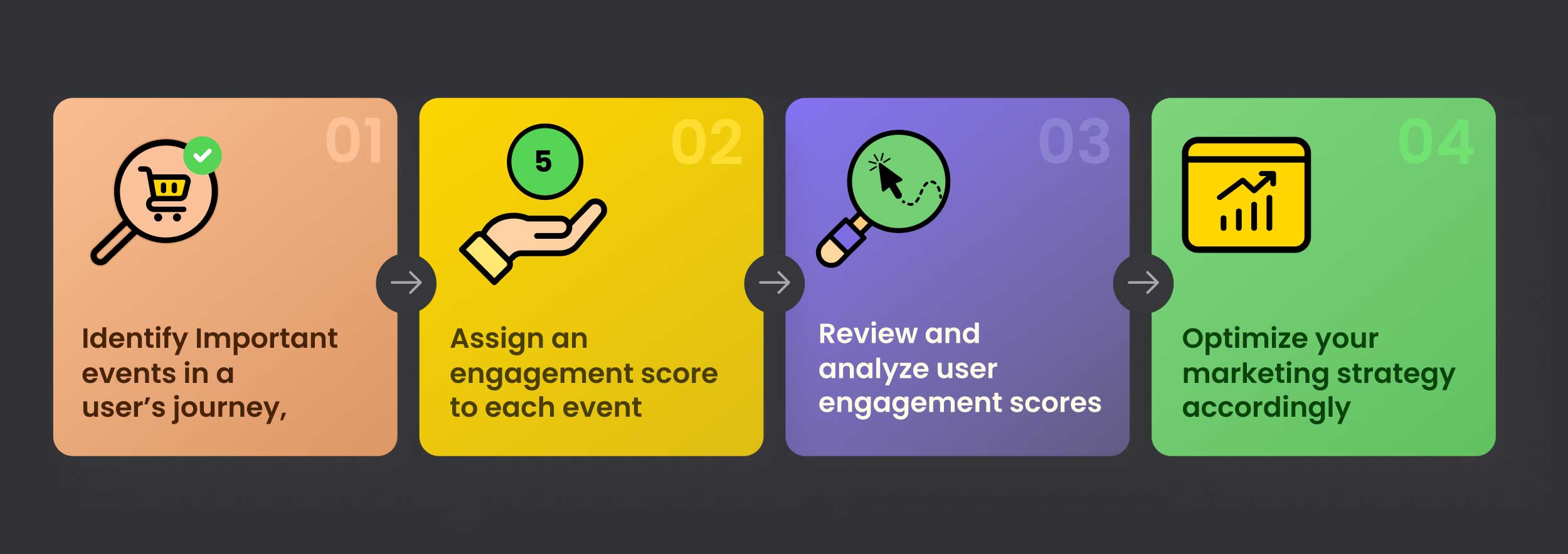As marketers, we want to deliver contextual messages so users can derive value from such communications. This strategy not only positively impacts your bottom line, such as conversions, but also improves customer engagement metrics, such as email opens, clicks, and more.
And, let’s not forget – adding value attracts more customers and grabs their attention. To achieve this, is the segment-based approach enough? Is a segment such as users within a specific age range or gender enough to give a sense of whether your messaging is accurate or if your message will resonate with each user in the segment? Probably not.
Beyond user action and attribute-based segments, it is necessary also to understand
- Are users engaging with your emails?
- How many users click on push notifications they receive?
- And how many users actually land on your website?
But how do you measure these interactions between users and your brand and their usage of your product? We have just the right solution.
Introducing Engagement Score by WebEngage
Now, augment your campaign engagement with our engagement score feature. Adopt a nuanced approach to your segmentation strategy and easily track user engagement on your WebEngage dashboard:

Our system automatically assigns a score to users within the range of 1-10 based on their actions. Scores between 1-3 represent the lower end of the spectrum and indicate users who engage the least, and scores between 7-10 represent the higher end and point to highly engaged users. However, you can customize the criteria for engagement scores for each user as per your business goals and needs.
For instance, email opens can be assigned a weightage of 3. Whereas an email click can be given a weightage of 5, as clicks represent a deeper engagement than opens.
Interested in trying? Reach out to your Customer Success Manager or write to us at product@webengage.com to experience this access-control feature.
Calculating Engagement Score
You can calculate engagement scores without any limitations, i.e., select different data points, such as custom and system events, to arrive at a score for each user. Additionally, you have the flexibility to create multiple engagement scores for different goals.
Engagement score calculation is an easy 3-step process:
Step 1: Identify and define your engagement goals:
Start by understanding how users engage with your product throughout their journey. This will help you identify important events for the user to complete their journey successfully. These events include both system and custom events and signal the behavior of an engaged user for each user persona segment.
Step 2: Assign weightage to each event
Now, assign weightage to each event based on its importance to your engagement strategy and user journey. Therefore, events of the least significance should be given the lowest score, such as between 1-5 on a scale of 1-10. Events of higher significance should be assigned a higher score, such as above 5 on a scale of 1-10.
Step 3: Let our algorithm calculate engagement scores for your users
The event values combined give you the engagement score for your users, based on which you can determine if the user is a less engaged or highly engaged user.
Our system allows you to create multiple engagement scores. The engagement scores can also be based on the channel, events can be determined for a particular channel, and weights can be assigned to those events. Here are some examples to help you get started:

What Value Does It Add?
1. Think Small: Nuanced Segmentation, Contextual Message
Make your existing segments more nuanced by filtering users based on their engagement scores. Accordingly, target these users with various contextual messages to achieve multiple goals and objectives. For example, offer additional perks to users with an engagement score between 8 to 10 and provide conditional offers to users with an engagement score between 5 to 8.
2. Lead Users Towards A Desired Goal
Create multiple engagement scores based on different scoring criteria, such as email interactions, page views, CTA clicks, etc., and lead users toward the desired goal in line with their engagement score. For example, target least engaged users with feature walkthroughs to help them see your product’s value and prevent churn, and highly engaged users with rewards for their loyalty to retain them.
3. Monitor User Health and Improve Communications
Measure user engagement levels based on their interactions with your brand and usage of your product. The higher the score, the healthier and happier the user. Depending on the user’s health, you can communicate with them via one-time campaigns or add a segment block in journeys to expand on a conditional logic-based approach.
Making it a Part of Your Engagement Strategy
Engagement score can dictate your segmentation and message strategy in various ways. Here are some strategies to inspire you and help you drive conversions:
1. Customize engagement score aimed at increasing insurance purchases
Create customized engagement scores to help identify customers with the highest propensity to purchase insurance and related products. Accordingly, target these customers with complimentary offers, wellness monitoring, and product recommendations to drive purchases.
2. Nudge learners towards successful course completion.
Filter users requiring a nudge to complete the course successfully basis their engagement scores. Highlight learning outcomes and positive customer reviews to encourage engagement and gamify elements to make the learning experience fun.
3. Offer strategy different for different users based on purchase amount
Create multiple engagement scores based on different purchase amounts and send targeted communications in line with these scores to achieve various goals. For instance, send product recommendations to users with scores between 1-4 to increase their purchase amount and special offers to users with scores above 8 to reward them.
4. Monitor subscriber health
Use time spent on your platform as the criterion, create engagement scores accordingly, and monitor subscriber health. Nudge users with scores below 5 to watch top viewed/trending shows to increase their engagement level and create a personalized watchlist for users with scores above 5 to maintain their engagement level.
5. Experiment with the frequency of your communication
Send customer journey-based orchestrated communications and change their frequency depending on engagement scores. For users with lower scores, restrict communications to disseminating important information or occasional promotional campaigns. In contrast, communications can be more frequent for users with higher scores and driven toward loyalty programs and referrals.
6. Increase AOV for users with high engagement scores
Encourage users with higher engagement scores to increase their average order values, as they are better-suited candidates for cross-sell/upsell. You can achieve this with exit-intent popups, offering freebies and limited-time discounts, and starting a customer loyalty program.
Wrapping Up
The correlation between user engagement and churn is high, and our engagement scoring feature is a great predictor of churn that evaluates your overall product health. Accordingly, you can revamp your segmentation strategy, augment your campaign creation process and send improved targeted communications. Thus, enhancing user experience and cultivating loyalty amongst your users.
We hope you try out this feature and share your feedback. If you need more assistance, get in touch with your Customer Success Manager or reach out to product@webengage.com to get started.
Test and measure the impact of your campaigns with WebEngage. Take a demo today!



































 Kasturi Patra
Kasturi Patra
 Prakhya Nair
Prakhya Nair



